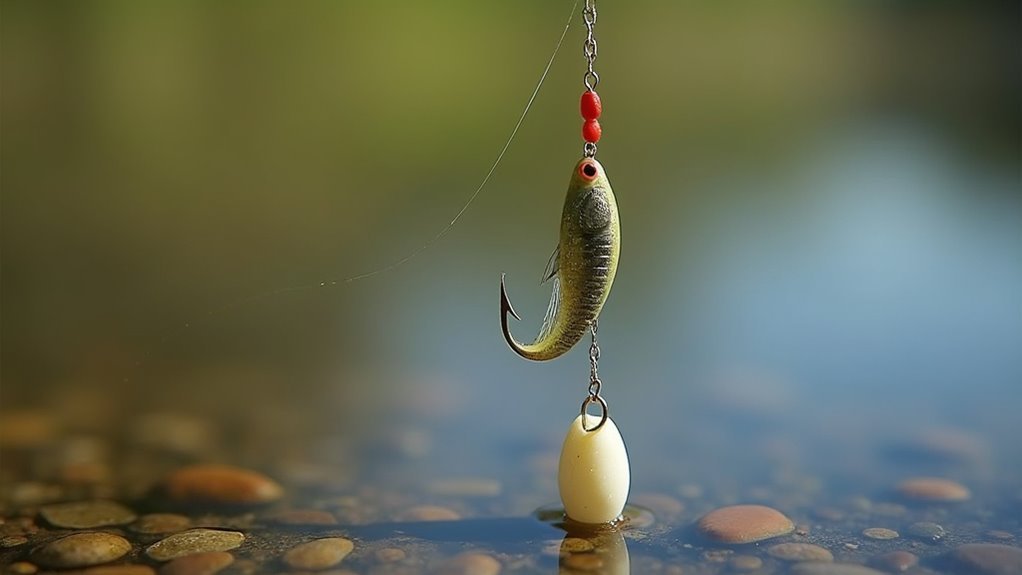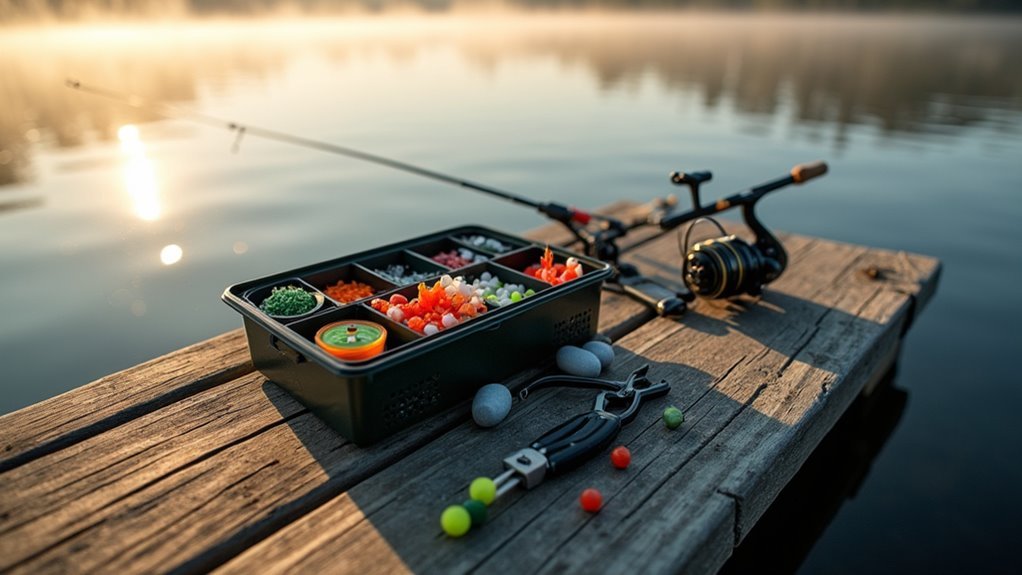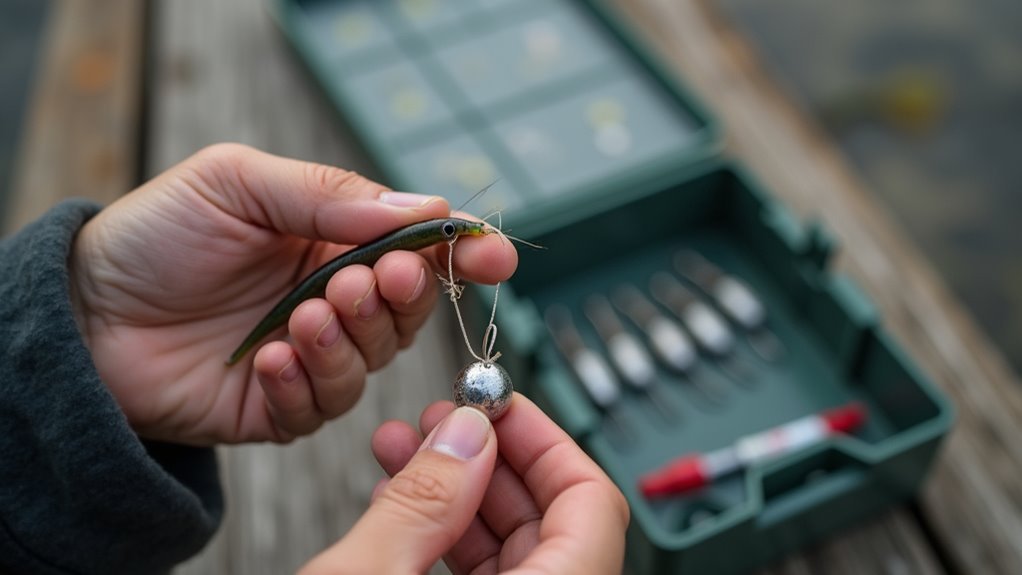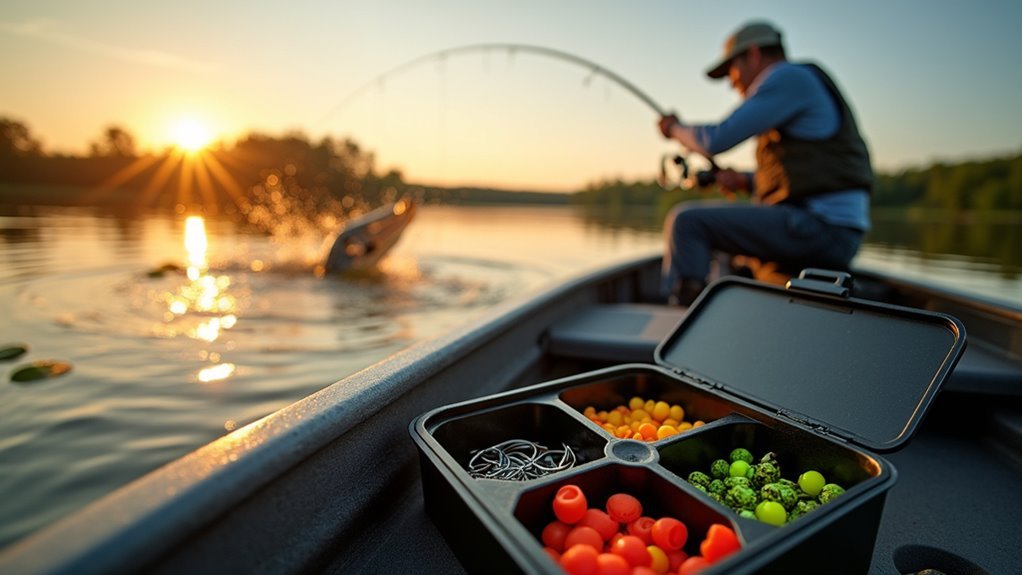We’ve found the drop shot rig to be a game-changer for bass in clear water when nothing else works. It’s simple but deadly: use 6-pound fluorocarbon line, size 1 hooks, and match your weight color to the bottom. Rig your plastic worm horizontally, let it hit bottom, and work with subtle twitches. Don’t rush it—bass love that subtle presentation. Our biggest catches often come when we’ve slowed down and let the bait do the talking.
The Anatomy of an Effective Drop Shot Rig

Simplicity is the beauty of a drop shot rig, and I’ve seen it work magic on even the most pressured bass. Let’s break down what makes this setup so deadly effective.
You’ll need just three key components: low-visibility line (6-pound fluorocarbon is my go-to), size 1 drop shot hooks, and crimped swivel weights around ⅜ ounce.
I once fished a crystal-clear lake where nothing was biting until I tied on a drop shot with a natural-colored weight. The bass couldn’t resist! Remember, choose weights that blend with the bottom – dark for muddy bottoms, light for sandy areas.
Essential Gear and Components for Drop Shot Fishing

While you don’t need fancy equipment to master drop shot fishing, having the right gear makes all the difference when those finicky bass are playing hard to get. We’ve learned through countless hours on the water that low-visibility fluorocarbon (around 6-pound test) works best for your line.
Pair that with size 1 or 1/0 drop shot hooks and crimped swivel weights starting at ⅜ ounce. The weight color should match your surroundings—dark for muddy bottoms, light for sandy areas.
For bait, plastic worms or rubber minnows are our go-to choices. I’ve caught some real lunkers using this simple setup!
Step-by-Step Guide to Rigging the Perfect Drop Shot

Now that you’ve got your gear ready, let’s put it all together! Rigging a drop shot isn’t rocket science, but getting it right makes all the difference.
First, thread your line through the hook eye, leaving about a foot of tag end. Form a small loop and pass it back through the eye, then tie a Palomar knot. Always wet the knot before tightening!
Next, rig your plastic worm or minnow horizontally on the hook. Finally, attach your weight to that tag end.
We’ve caught countless bass this way when nothing else worked!
Proven Drop Shot Techniques That Land More Bass

The best drop shot fishermen separate themselves from the crowd with technique, not just proper rigging. We’ve found four approaches that consistently produce:
First, try deadsticking—let your weight hit bottom, hold steady, and give occasional subtle twitches. This mimics an injured baitfish perfectly.
When fishing current, choose a weight that maintains contact with the bottom without getting swept away.
Near cover, drag your weight along structure and shake when you feel contact.
For pressured bass, the quick-drag technique creates just enough commotion to trigger reaction strikes.
We’ve seen even the most stubborn bass cave to these methods!
Seasonal Strategies for Drop Shot Success

Seasonal adjustments to your drop shot approach can dramatically increase your success throughout the year. In spring, we target pre-spawn bass in staging areas using smaller profile baits on shorter leaders. Summer calls for deeper water presentation with longer 12-18 inch leaders, where we’ll deadstick near structure to entice lethargic fish.
Fall’s about following baitfish migrations—use shad imitators and work mid-depth ranges. Come winter, slow everything down. We’ve caught monster bass in 30-foot holes using micro-movements and 6-inch leaders. I remember landing a 6-pounder last December when the bite seemed impossible—just a slight rod tip quiver made all the difference.
Common Drop Shot Mistakes and How to Avoid Them
Despite mastering the basics of the drop shot rig, many anglers continue making avoidable mistakes that cost them trophy bass. We’ve all been there – I once spent an entire afternoon wondering why I couldn’t get a bite until I realized my leader was way too long!
The most common errors we see include using weights that are too heavy, rigging worms upside down, and fishing too fast. Remember, bass often want that subtle presentation. When your buddy’s hauling in fish after fish, check your leader length and slow down your movements. Your rod tip should barely twitch – let the bait do the work.
Frequently Asked Questions
Can the Drop Shot Rig Be Effective From Shore Fishing?
Yes, we can effectively use drop shot rigs from shore. We’ll need to cast toward structure or depth changes, use appropriate weight for shore conditions, and work our bait with subtle rod movements.
How Does Water Clarity Affect Drop Shot Color Selection?
Clear as crystal, clear your mind! In clearer water, we’ll want natural, translucent colors that don’t spook fish. For murky water, we’d choose brighter, more visible colors like chartreuse or white to help bass locate our bait.
What’s the Ideal Rod Action for Detecting Subtle Drop Shot Bites?
We recommend a medium-light to medium rod with a fast action tip for drop shot fishing. It’s sensitive enough to detect those subtle nibbles while providing enough backbone to set the hook effectively.
Does Drop Shotting Work Well at Night or Low-Light Conditions?
Early bird gets the worm—and so do night anglers with drop shots! We’ve found they’re excellent in low-light conditions when bass move shallower to feed. Just use darker, more visible baits for best results.
Can Drop Shot Rigs Be Used Effectively in Heavy Vegetation?
Yes, we can use drop shot rigs in heavy vegetation with modifications. We’ll need weedless hooks, lighter weights, and shorter leader lengths. Punching through openings or working edges of vegetation works best for us.
Conclusion
We’ve cast our line through the depths of drop shot fishing, and now it’s up to you to reel in the results. Like the patient heron waiting by the shore, your perfectly suspended bait will become the silent predator of the deep. We’ve seen countless trophy bass fall for this technique on foggy mornings when nothing else worked. Remember, in your hands, this simple rig becomes the key that opens the underwater door to bass fishing success.